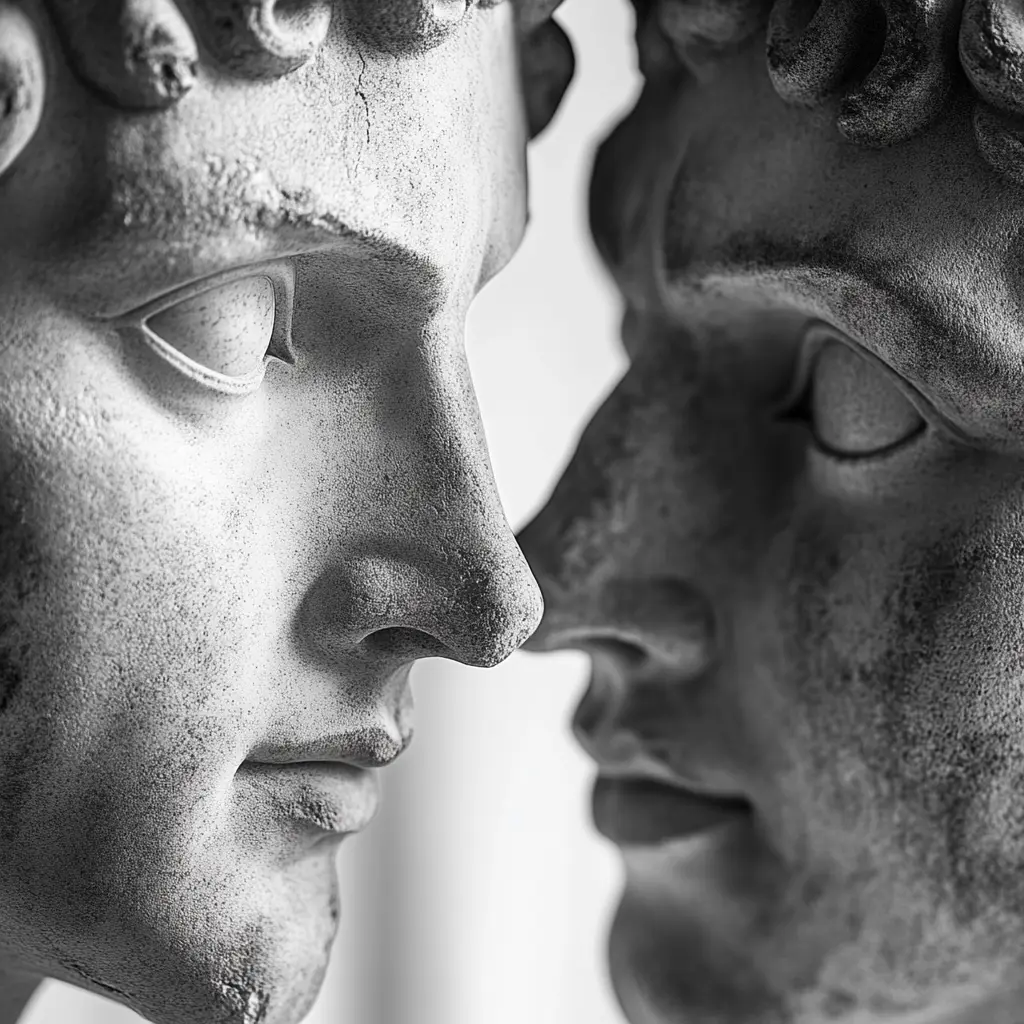Relationship Red Flags by Type
| Type | What Attracted You | What It Becomes | Run When… |
|---|---|---|---|
| Type 1 | High standards, integrity | Constant criticism, nothing’s good enough | You’re walking on eggshells daily |
| Type 2 | Caring, attentive | Guilt-tripping, emotional debt | Help feels like hostage-taking |
| Type 3 | Confident, successful | Fake, uses you as a prop | You realize you don’t know the real them |
| Type 4 | Deep, passionate | Emotional vampire, endless drama | Their crisis is always your emergency |
| Type 5 | Smart, independent | Emotionally unavailable, condescending | Having needs makes you feel stupid |
| Type 6 | Loyal, committed | Paranoid, constant loyalty tests | You’re always proving yourself |
| Type 7 | Fun, spontaneous | Avoids all depth, commitment-phobic | Serious conversations make them vanish |
| Type 8 | Strong, protective | Controlling, intimidating | Disagreement triggers aggression |
| Type 9 | Easy-going, peaceful | Passive-aggressive, disappears | Your needs become invisible |
That "quirky trait" you found endearing on your first date? Six months later, it's driving you insane.
We’ve all been there.
What starts as charming quickly morphs into toxic. But why does this happen? And more importantly, how can you spot the warning signs before you’re in too deep?
When Survival Strategies Become Toxic Patterns
Most toxic behaviors aren’t random. They’re survival strategies gone wrong.
Think about it. We all develop coping mechanisms to navigate life’s challenges. To protect ourselves. To get our needs met.
But in relationships? These mechanisms get tested. Hard.
And here’s the mind-bending part: Many toxic traits initially seem attractive. The confidence that later reveals itself as control. The helpfulness that becomes smothering. The passion that turns into volatility.
The Enneagram offers a unique window into these patterns. It doesn’t just label behaviors—it exposes the why behind them.
Why We’re Drawn to Toxic Traits (Against Our Better Judgment)
Ever wondered why you keep dating the same “type” even when it ends badly?
Psychology has an answer. We’re often attracted to traits we lack in ourselves.
The quiet, reserved person falls for the life of the party. The indecisive one admires someone commanding and sure. The emotionally guarded individual is drawn to intense passion.
But these attractions carry a shadow side.
That commanding presence? It might become controlling. That passionate intensity? It could turn into emotional volatility. That helpful nature? Watch for martyrdom and manipulation.
Let’s break down how these toxic traits manifest for each Enneagram type—and what they look like in real relationships.
Toxic Relationship Patterns by Enneagram Type
Type 1: The Perfectionist’s Relationship Critique
Behind a Type 1’s toxic traits lies a desperate fear: the terror of being corrupt, wrong, or imperfect. In relationships, this fear manifests in ways that can suffocate their partners and poison connection.
The Criticism That Never Ends
“You loaded the dishwasher wrong again.”
“That’s not how you should talk to my mother.”
“You really should have planned this better.”
For Type 1s, these aren’t just casual comments—they’re moral imperatives. They truly believe they’re helping. Improving. Perfecting.
Their partners experience it differently. As a drip, drip, drip of criticism that erodes self-confidence and creates walking-on-eggshells anxiety.
Rigid Rules Nobody Asked For
A Type 1 might create an elaborate system for organizing the refrigerator—then silently seethe when their partner doesn’t follow it.
They might plan vacations with military precision, becoming visibly distressed when spontaneity disrupts their vision of the “right way” to enjoy leisure time.
This inflexibility kills joy. Spontaneity becomes impossible. Simple decisions become moral tests.
The Moral High Ground (Population: Just Them)
“I can’t believe you watch that trash.”
“I would never waste time the way you do.”
Type 1s often position themselves as the moral authority in relationships. They create hierarchies of virtue where they inevitably occupy the highest position.
This creates a parent-child dynamic that’s poison to romance. How can true partnership exist when one person constantly positions themselves as superior?
Type 2: The Helper’s Suffocating “Love”
Type 2s fear being unlovable at their core. Their toxic relationship behaviors stem from a desperate attempt to earn love by becoming indispensable. But this strategy often backfires spectacularly.
Love as a Transaction
“After everything I’ve done for you…”
This phrase—or some version of it—is the Type 2’s toxic weapon of choice. Their acts of service come with invisible strings attached.
A Type 2 might spend hours cooking an elaborate meal, then use this “generosity” to manipulate their partner into canceling plans with friends. The message is clear: my kindness must be repaid.
This creates a debtor’s prison relationship where love becomes a transaction, not a gift.
Your Boundaries? What Boundaries?
“I was just trying to help!”
Type 2s often violate relationship boundaries under the guise of love and concern. They might read private messages to “make sure everything’s okay.” They show up uninvited to events because “you might need me.”
This behavior stems from their need to be needed, but it creates an invasive, claustrophobic dynamic where privacy disappears.
Martyrdom as Manipulation
“Don’t worry about me, I’ll be fine alone…”
Type 2s frequently neglect their own needs, then weaponize this self-neglect to control their partners. They might always defer to their partner’s restaurant choice, never expressing their own preference—until they explode with accumulated resentment.
This creates a minefield of unspoken expectations that their partner must navigate blindly.
Type 3: The Achiever’s Image-Obsessed “Connection”
Type 3s fear worthlessness above all else. Their toxic traits emerge from a desperate attempt to be valued for their accomplishments and appearance, often at the expense of authentic connection.
The Instagram Relationship vs. Reality
“Wait, let me get a picture of us kissing in front of the sunset!”
Type 3s may invest more energy in how their relationship appears than how it actually feels. They curate perfect social media narratives while ignoring fundamental problems.
A Type 3 might insist on professional couple photos to project success while avoiding difficult conversations about financial struggles or emotional distance.
The Constant Competition
“Did you see Mark and Sarah just bought that beach house? We need to step up our game.”
Type 3s often turn relationships into competitions, measuring success against external benchmarks. They view their partnership as another achievement to optimize and showcase.
This creates exhausting pressure where the relationship becomes a performance, not a sanctuary.
Absent While Present
“Sorry, I need to take this call.”
Type 3s frequently prioritize work and achievement over emotional presence. They might physically attend date night but mentally remain at the office.
A Type 3 might spend an entire anniversary dinner checking emails or networking with nearby diners, leaving their partner feeling invisible and unimportant.
This creates a profound loneliness—the special pain of being alone while together.
Type 4: The Individualist’s Dramatic Love Story
For Type 4s, the core fear is having no identity or personal significance. Their toxic relationship behaviors emerge from a desperate need to feel unique, deep, and authentic—even when this pursuit creates chaos.
Emotional Whiplash
“I’ve never felt so connected to anyone.” (24 hours later) “You don’t understand me at all. No one ever will.”
Type 4s often subject partners to extreme emotional volatility. One day, they’re deeply in love; the next, they’re questioning everything.
This unpredictability isn’t manipulation—it’s how they actually experience their emotions. But for partners, it creates a destabilizing environment where security feels impossible.
The Perpetual Search for “More”
“This is nice, but something’s missing.”
Type 4s can maintain a chronic dissatisfaction with their relationships, always sensing an elusive “something” that would make love perfect. They compare their real relationship to an idealized fantasy that no human connection could fulfill.
This creates a painful cycle where partners feel perpetually inadequate, trying to satisfy an unachievable standard.
The Beauty in Brokenness
“Our fights just show how passionate we are about each other.”
Type 4s sometimes romanticize relationship dysfunction, mistaking drama for depth. They might subconsciously create conflicts before important events, believing the emotional intensity makes experiences more meaningful.
This pattern keeps relationships in perpetual turmoil, mistaking chaos for connection.
Type 5: The Investigator’s Emotionally Detached Love
Type 5s fundamentally fear depletion—having inadequate resources or energy to engage with the world. Their toxic relationship patterns stem from attempts to conserve themselves in ways that often leave partners emotionally starved.
The Emotional Robot
“I don’t understand why you’re crying about this.”
Type 5s may respond to emotional situations with detached analysis rather than empathy. When their partner shares feelings, they offer solutions instead of emotional connection.
A Type 5 might intellectualize a grief experience or relationship conflict, leaving their partner feeling unseen and unvalidated.
This creates a painful empathy gap where emotional needs go chronically unmet.
The Secret Vault
“No, I don’t want to talk about my day.”
Type 5s often maintain excessive privacy, even in intimate relationships. They compartmentalize their lives and guard information as if sharing it might drain them.
A Type 5 might have entire areas of interest, concern, or activity they never share with their partner. They may need extreme amounts of alone time without explanation.
This creates a one-sided intimacy where partners feel perpetually kept at arm’s length.
The Intellectual Superiority Complex
“Actually, that’s not correct. Let me explain how it really works…”
Type 5s may weaponize knowledge in relationships, using intellectual superiority as a defense mechanism. They might correct their partner publicly or dismiss their ideas without consideration.
This creates an intellectual hierarchy that undermines the equal partnership needed for relationship health.
Type 6: The Loyalist’s Fear-Based Love
Type 6s are driven by fear of abandonment and a deep need for security. Their toxic relationship behaviors often stem from anticipating dangers that don’t exist, creating the very instability they most fear.
The Relationship Detective
“Who were you just texting? You smiled differently.”
Type 6s may subject partners to constant surveillance and questioning, always looking for evidence of potential betrayal. This hypervigilance stems from anxiety, not control.
A Type 6 might regularly check their partner’s phone or question innocent interactions with others, creating an atmosphere of suspicion rather than trust.
Disaster Preparedness as a Lifestyle
“What if you’re just staying until something better comes along?”
Type 6s often anticipate worst-case scenarios in relationships. They mentally rehearse breakups, betrayals, and rejections—then react emotionally as if these imagined scenarios were actually happening.
This creates a self-fulfilling prophecy: by preparing for abandonment, they create the emotional distance that leads to it.
Love as a Continuous Test
“I didn’t answer your calls to see if you’d worry about me.”
Type 6s sometimes create loyalty tests, unconsciously setting up scenarios to measure their partner’s commitment. They might deliberately act distant to see if their partner notices and pursues connection.
These tests are rarely passed because the rules are unclear and constantly changing—rooted in anxiety rather than clear communication.
Type 7: The Enthusiast’s Commitment-Phobic Love
Type 7s are driven by fear of pain, limitation, and deprivation. Their toxic relationship patterns stem from avoiding emotional discomfort in ways that prevent genuine intimacy.
The Escape Artist
“Let’s not put a label on this.”
Type 7s often avoid full commitment, keeping escape routes open even in seemingly serious relationships. They might refuse to define the relationship or make long-term plans, keeping partners in perpetual uncertainty.
This creates a painful imbalance where one person is all-in while the other keeps one foot out the door.
Shiny Object Syndrome
“I met this amazing person at the coffee shop today!”
Type 7s may struggle to maintain focus on their relationship, constantly seeking new stimulation. They might become visibly more energized by strangers or new acquaintances than their actual partner.
A Type 7 might plan elaborate dates but struggle to engage in the mundane maintenance that sustains real intimacy.
This creates a sugar-high relationship—exciting but ultimately unsustaining.
The Emotional Surface Skater
“Why focus on that? Let’s have fun instead!”
Type 7s often avoid emotional depth, deflecting serious conversations with humor or changing the subject. When partners bring up relationship concerns, they might redirect to more pleasant topics.
This emotional avoidance prevents the vulnerability necessary for true connection, creating a relationship that feels fun but empty.
Type 8: The Challenger’s Domineering Love
Type 8s fear vulnerability and being controlled by others. Their toxic relationship patterns emerge from protection mechanisms that often hurt the very people they care about most.
The Relationship Dictator
“We’re doing this my way. Trust me, it’s better.”
Type 8s may control major aspects of the relationship without consultation, believing they know what’s best. They might make unilateral decisions about finances, living situations, or social plans.
A Type 8 might pressure their partner to change jobs or cut off friendships they deem “negative influences,” all under the guise of protection.
This creates a parent-child dynamic that suffocates equal partnership.
Anger as the Go-To Emotion
“How could you be so stupid?”
Type 8s often express all emotional vulnerabilities—hurt, fear, insecurity—as anger instead. They might respond to minor disappointments with intimidating rage.
This creates an environment where partners walk on eggshells, afraid to trigger unpredictable outbursts.
The Emotional Fortress
“I’m fine. Drop it.”
Type 8s frequently conceal tender emotions behind impenetrable walls. They might respond to expressions of love with jokes or deflection, rejecting vulnerability even with those closest to them.
This emotional unavailability creates a profound disconnection, where partners feel they can never truly reach the Type 8’s heart.
Type 9: The Peacemaker’s Passive-Aggressive Love
Type 9s fear conflict and separation above all else. Their toxic relationship patterns emerge from peace-keeping strategies that ironically create deeper disconnection.
The Silent Treatment Master
“No, nothing’s wrong.” (Everything is wrong)
Type 9s often avoid direct confrontation at all costs, expressing displeasure through withdrawal, silence, or passive aggression. They might agree to plans they resent, then “forget” to follow through.
A Type 9 might outwardly agree with their partner while internally building a case against them, leading to confusing mixed messages and unexplained distance.
This conflict-avoidance creates more damaging conflict than direct communication ever would.
The Emotional Novocaine
“It doesn’t really matter to me.”
Type 9s frequently numb their emotions to maintain internal peace, creating an emotional flatline that leaves partners feeling disconnected. They might respond to both crises and joys with the same level detachment.
This emotional unavailability creates a profound loneliness for partners, who feel neither positive nor negative emotions are truly shared.
The Disappearing Self
“Whatever you want is fine with me.”
Type 9s may completely surrender their preferences, opinions, and even identity to merge with their partner. They adapt to their partner’s lifestyle, friends, and interests until their own self becomes nearly invisible.
This self-erasure ultimately breeds resentment and prevents the authentic connection that comes from two whole individuals choosing each other.
Breaking Toxic Patterns: From Awareness to Action
Recognizing toxic traits is just the first step. Real change requires deeper work.
The Path to Healthier Relationships
Develop ruthless self-awareness. Ask yourself: “What am I afraid of in relationships? How might this fear drive my behavior?”
Create psychological safety. Build an environment where honest communication is welcomed, not punished.
Establish clear, compassionate boundaries. The healthiest love has fences, not walls.
View relationship struggles as growth opportunities. Every conflict contains a lesson about yourself.
Know when to seek professional help. Some patterns are too entrenched to break alone.
Remember: The goal isn’t perfection. It’s progress.
Revealing Questions: The Window to True Character
Want to spot toxic traits early? Ask these revealing questions:
“Tell me about a mistake that taught you something important about yourself.”
“How do you typically handle disagreements with close friends or family?”
“What’s something about yourself you’re actively working to improve?”
“Describe a time when you had to admit you were wrong about something important.”
“How do you balance your own needs with those of others in your life?”
These questions reveal more than any dating profile ever could. They illuminate self-awareness, emotional intelligence, and relationship patterns.
Beyond Toxic Traits: The Possibility of Growth
Here’s the beautiful truth about the Enneagram: it doesn’t just diagnose problems—it maps pathways to growth.
Every toxic trait has a healthy counterpart:
- The Type 1’s criticism can transform into discernment that helps others grow.
- The Type 2’s manipulation can evolve into genuine nurturing without strings attached.
- The Type 3’s image obsession can mature into authentic achievement that inspires others.
The journey from toxic to healthy isn’t easy. It requires courage—the courage to face your own shadows and choose a different path.
But it’s worth it. Because on the other side of this work is what we all truly want: the ability to love and be loved without fear getting in the way.
What steps will you take today to bring more awareness to your relationship patterns?
Learn more about how to communicate effectively in relationships here.


